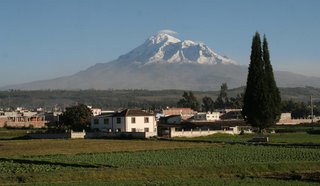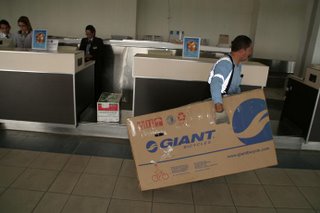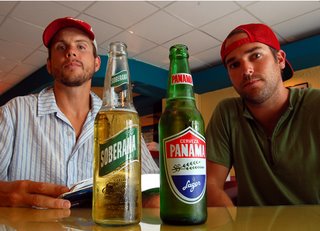*This was the longest stage of the trip to date and has resulted in a marathon travel update. It´s divided it into three parts -- Introduction, A (Guatemala, El Salvador, Honduras) and B (Nicaragua, Costa Rica, Panama). I´ve also added some photos that are NOT in the Gallery and Web-links to break it up a bit. The complete gallery for this stage is online in the Gallery section of this Web site.IntroductionStage 2, Part 5 was the most emotionally exhausting and culturally intense of the trip to date. After being attacked with machetes by masked bandits in southern Mexico, my closest friend and cycling partner, Brooks, decided that he didn´t feel comfortable about continuing south on a bicycle and returned home. Paralyzed by fear after our attack and depressed by the near collapse of my journey, I put my bike in storage and spent several weeks checking out the Semana Santa processions, coffee shops and local watering holes of Antigua, Guatemala. My salvation came in the form of an email from
Ruth and Horst, a Swiss and German cycling duo who were interested in joining forces through the remainder of Central America. After meeting up in Antigua, the Europeans pumped me full caffeine and nursed my spirit back to health as we pedaled 1,650 miles through 6 countries, trading Mayan ruins for coffee plantations, national parks, and a string of 13 towering volcanoes. I experienced poverty to the breadth and depth that I never dreamt possible, spectacular beaches and wildlife, incredibly gracious hosts, palacial residences, and cosmopolitan capital cities. By the time I reached the Panama Canal, marking my completion of nearly 10,000 miles of cycling through North and Central America, not only had the land and people changed considerably but, for the first time in the trip, I could feel myself starting to change too.
Stage 2, Part 5 (A) - Guatemala, El Salvador, Honduras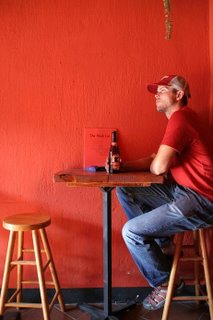
This stage officially began over an intense cheek biting session and several Gallos (Guatamalan Beersks) at the Black Cat Bar in Antigua just after my parents, brother, Alexis, Brooks and Nathalie hopped on planes back to the US. At that moment, it hit me like a ton of cobblestones, I was truly alone for the first time in 8 months and had no clue about what I was going to do next. Gallo #4 delivered the courage I needed to commit to "Argentina or Bust" via two simple options: 1) keep traveling on my bicycle or 2) keep traveling on something besides my bicycle. In order to choose option # 1, I needed to make sure that I could still manage my nerves and enjoy pedaling through countries where, every 1/2 mile or so, there´s a group of men hacking things apart with machetes on the side of the road.
The next morning I tore myself out of bed at the crack of dawn and hauled a mountain bike up Volcan de Agua.
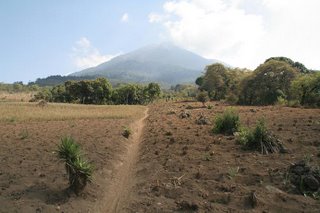
This was my test; if I could make it back down to Antigua in one piece and have fun at the same time, I would continue cycling. Two hours later, while ripping down an exceedingly scenic section of singletrack, I lost control of my front wheel, flipped over the handlebars and face planted into a corn field. As I picked the pebbles out of my legs, arms and mouth, I rolled over to see a group of firewood toting farmers chuckling at my misfortune. This scene, paired with the huge dome of the volcano in the background sprouted a huge grin on my face for the first time in several weeks. That was that, cycling was fun again, and I immediately exhumed the Geoduck (the name of my touring bike) from it´s storage shed on the Rio Tatin.
I originally met Ruth and Horst in a hostel 2 months before in Zacatecas, Mexico. We spent the evening on a roof-top terrace cooking a huge pasta dinner and making fun of our friend
David, as his well-spoken Stanford vocabulary slipped into unintelligible babble after his 4th Tecate. I knew that we would get along well and was excited to cycle through Central America together. Before our departure in Antigua, I popped into the local police department to inquire about the safety of the road to El Salvador. Their response was clear--the road ahead was not safe. "You will likely be robbed", "It´s not the size of their guns you should worry about but rather the size of their bullets" etc., etc. My frustration eased when they offered us a very sensible and free solution in the way of a full police escort to the border. We spent the next two days turning our cranks down "Volcano Valley" and along the Pacific Coast in the company of at least 3 sawed-off shotgun carrying police officers.
As we neared the Salvadoran border, the temperature soared to over 100 degrees. This kicked off a scorching trend that would continue for 15 of the next 18 days, peaking at 118 degrees in Honduras where a block of cheese melted completely during a five minute walk from the grocery store to my hotel. Another trend that emerged at the border was extreme poverty. Along the coastal road through El Salvador, many of the homes had no walls and plastic bags stitched together for roofs. The roadside stores rarely had food and children did not have shoes. Because of the massive amount of foreign aid pouring into the region, the roads were all brand new and butter smooth with little traffic as nobody can afford a car. Most of the people in El Salvador were extremely friendly and taught me a lot about the country´s violent civil war. Basically, if you are El Salvadoran, over 20 years old, and still alive, chances are that many of your friends and family were brutally killed.
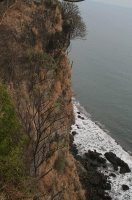
One local took me to a cliff-side vista point over the Pacific, pointed down to the rocky shore several hundred feet below and informed me that this was the mass dumping ground, "Dead Man´s Cliff", for thousands of mangled bodies (including some of his friends) during the war. Strangely, it´s now the site of a tourist resort and restaurant. In the mountain town of Juayua, I was invited to tour a coffee production facility and, um, kind of sort of accidentally wandered off into the sweat-shop room. That night I tossed and turned for hours at the vision of these women picking through millions of coffee beans being carried on a conveyer belt under a flickering fluorescent lightstrip. A game show like buzzer system regulated their labor in 30-second intervals. "Ding, ding, ding, ding" meant start picking and "buzz, buzz, buzz, buzz" meant stop picking. They do this all day long, 7 days per week. The high grade beans are purchased by Starbucks (see photo gallery for more).
The next morning, while strolling down the beach near Libertad, a man stopped me because he heard that I was an American. He presented me with a weathered picture of his daughter and asked if I had ever seen her in the US. I apologized and told him that I had never seen her before and asked why he was targeting me. He explained that during the war a death squad killed almost everyone in his village and then burnt it down. He was presumed dead and a missionary group adopted his daughter to a US family. He has been looking for her ever since. After he left I checked my shorts to make sure that I didn`t just get pick-pocketed. Everything was still there so I`m assuming that he was telling the truth.
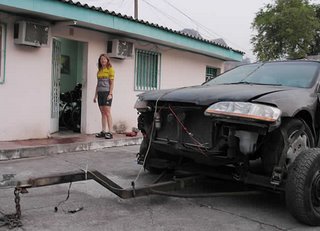
We entered Honduras in the sketchy border town of El Amatillo where I broke my trip record of "worst hotel room". It was a concrete block situated in the middle of an auto demolition lot and a dump. Once per hour, a totaled out car would arrive on a tow truck from the US and a team of adolescent girls would start piecing it out. Thirty-minutes later, a group of men would show up for the heavy lifting and then the car would mysteriously disappear.
Honduras is the poorest country in the Western hemisphere and 90% of the population lives below poverty. Along our route, rich people barricaded themselves in housing complexes with armed guards and electric fences. Poor people lived in open air shacks butted up along the roadside. What this means for a touring cyclist is that you are going to see miserably poor people and they are going to see you all day long. The very first person I encountered while cycling into Honduras immediately ran to the side of the road shouting "gringo, gringo, gringo, give me your bags". At that point, I knew that Honduras was not going to be easy. The taunting continued as every person, in every house that we passed during the first day of riding either shouted "gringo, gringo, gringo"--"give me your money" or "give me your bags".
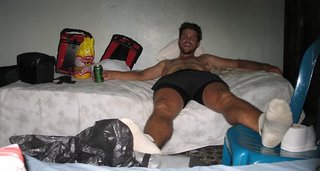
Often, the young boys would try to sling me recent roadkill victims that they had peeled off the tarmac, usually a lizard or Armadillo. The worst came near the mountain village of San Marcos where Ruth was followed up a steep hill by a pack of teenage boys shouting "give me your bags". A group of drunken adults on the side of the road encouraged their behavior by chanting "take her bags, take her bags". Just before things got out of hand, Ruth gave the crowd a few piercing looks and the kids backed off. I felt like Bill Gates riding a bicyle made of solid gold with diamond studded bags. Ironically, on this same day several of my friends back home sent emails commenting on what a dirty, poor, emaciated bum I looked like in a recent photo posting.
Along the Panamerican Highway most of the stores in small villages had barred entrances and we could not actually go inside of them to buy anything but had to tell people what we wanted and then pass money through a prison cell like doggy door. At one of these stores, I bought 6 mangos, 4 empenadas, and had my shirt stitched back together for 50 cents. I also discovered that almost everyone is unemployed in these villages. The entire economy is supported by a handful of relatives who have illegally immigrated to the US to work for a fast food company, agricultural employer, or as a family nanny. This was not just in one or two places but everywhere I went. If you´re reading this from the US, check it out yourself by striking up a conversation with a Latin American service worker. If they trust that you´re not going to turn them in to the Department of Immigration, I´m sure that the story of their illegal border crossing alone will blow you away. Remember, that in the US they may just be a lowly Taco Bell bathroom cleaner, but in Honduras they are idolized like rock stars as the $300 to $500 they send home per month can support an entire village.
I really did not enjoy cycling through Honduras. As a middle-class white guy from Seattle, I had a difficult time adapting to this country and went to bed every night with an upset stomach. However, in the safety of reminiscence, my travels in Honduras have become unbelievably valuable in erasing my naivetee about the world outside of the one I knew before this trip. I now travel through these poor areas with more realistic expectations.
Stage 2, Part 5 (B) - Nicaragua, Costa Rica, PanamaThe only thing I knew about Nicaragua prior to crossing the border was that there were 4 types of national beersks, all Lagers, and that I was looking forward to leaving Honduras and sampling all of them.
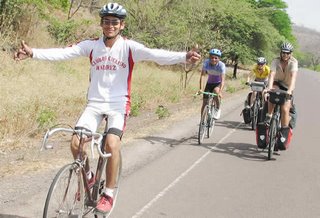
The first person that I met in Nicaragua was Rudy, the local Somoto club cycling champion. We hit it off immediately and the next day he and his friend, Roger, skipped work to cycle with us. I felt guilty for them playing hooky and asked if I could pay the equivalent of their daily wages for guiding us. They both work construction jobs for 12 hours per day, 6 days per week and make $40 per month. With two quick pedaling locals as our guides we hit several coffee plantations, cigar fincas, and did a bit of birding en route to Granada, a beautiful colonial town in the heart of Nicaragua. Rudy shared his dream of creating a youth cycling club to keep the local kids from sniffing glue and sampling the cocaine that flows heavily through the region en route to Honduras. I wish him the best of luck with building this program.
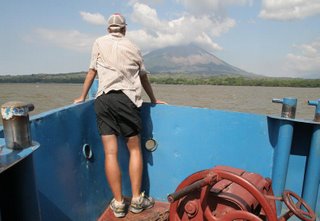
Next up on my agenda was a tour of volcano-packed Ometepe Island to celebrate the half-way point of my trip. On the ferry to the island, I met Mark, another American cyclist heading north from Colombia. We spent several days on the island camping along the the largest lake in Central America, hiking through nature reserves, drinking local rum and smoking hand rolled cigars.
From the island, Ruth, Horst, and I pedaled 30-miles to the Costa Rican border. I immediately knew that Costa Rica was a much richer nation than the rest of Central America because the dogs all had collars and started chasing me again. Just after the border, I met a German dive team who had chartered a boat to a small island off the coast of Santa Rosa National Park. They had space for one more and the next morning I found myself 60ft below the Pacific Ocean, eye to eye with large bull shark.

This kicked off a wanna be surf/safari and series of ten dives along the Pacific Coast ending with one of the best underwater experiences of my life at The Devil's Pinnacle in
Cano Island National Marine Reserve. There, I swam through a school of 500 manta rays, huge sea turtles, nurse sharks, dolphins, and an impressive group of several thousand barracuda.
After making a loop around the Nicoya Peninsula we headed into the mountains to visit Volcan Arenal, one of the most active volcanoes in Central America.
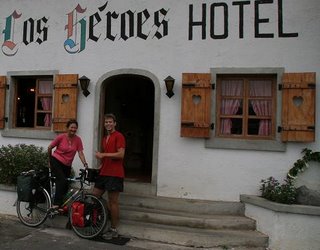
As we neared the volcano, I experienced the hospitality of two different Swiss couples on consecutive days. The first couple, after seeing that I was about to pitch my tent in a rainstorm, gave me a free room in their beautiful
Chalet with a 360 degree rotating restaurant overlooking Lake Arenal and the Volcano. The next day, while soaking sore muscles at a swanky hot spring resort, another pair of Swiss treated me to a touring cyclist´s ultimate food and drink combo--apple pie and ice cream accompanied by Imperial beersks!
From the mountains we descended 6,000 feet back to the beaches of the Pacific. This was the most dangerous section of road on the trip because the fog made it almost impossible to see. At one point we passed 3 different accidents in a 6 mile stretch.
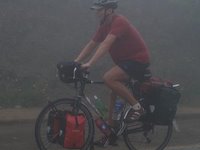
The national motto of Costa Rica is ¨Pura Vida¨ but in beach towns it´s actually ¨Pura Ganga¨. I knew that I was in beach town territory when a 1970´s muscle car with a cloud of smoke billowing out of the partially cracked passenger door window coasted up beside me. Next, a gold toothed, dread-locked, Costa Rican version of Chong extended his arm out of the window and passed me a HUGE joint. I considered taking him up on his offer but the fact that I still had 30 miles to pedal though 100 degree heat forced me to decline. ¨Your loss cyclista--Pura Vida¨ Chong exclaimed disappointingly as the muscle car sped away.
Just down the road from my Chong encounter, I was confused for a vagrant for the second time of the trip (see the Stage 1, Part 6 trip report for an account of the first time). I was taking a mid-afternoon stroll down Dominical beach and noticed a gaggle of bikini-clad American college girls eying me from their circle of conversation in the low surf break.
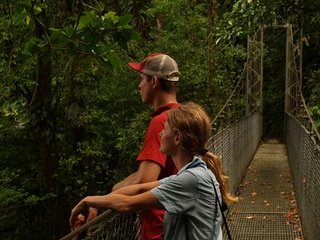
My slow swagger became a smooth strut and I experienced short-lived psychological boost from the idea that, at age 31, I still have it goin´ on enough to catch the attention of a group of 20-something co-eds. My ballooning ego quickly burst as I heard their ring leader assert ¨don´t worry, he didn´t steal anything¨-- just like that, their gazes shifted back to the surf. I glanced behind me and saw a pile of the requisite college traveling utilities that I had just passed; Ipods, GSM cell phones, thatched shoulder bags, tropical sarongs, designer sunglasses and stacks of glossy magazines. Along the coast, I also got my nature fix and was treated to sightings of Sloths, Ant Eaters, Crab Eating Raccoons, Toucans, Macaws, three types of Monkeys, and one 10-foot long constricting snake in Manuel Antonio and Corcovado National Parks. A two day stay on the incredible rooftop terrace of the
Lookout Hotel rounded out my very enjoyable and indirect route through Costa Rica.
I was looking forward to Panama as Brooks and I had been planning a reunion there which pretty much guaranteed a great time. Our misadventures began on the first day of his arrival in David, Panama. He was scheduled to pull into the city bus station at 9pm and I had agreed to meet him there. At 11:30 pm he had not arrived and the bus station was empty with the exception of a few prostitutes and other shady characters lingering around the taxi line. The night guards assured me that his bus was on the way, this was the only bus station in town, and his delay was probably due to problems at a Police checkpoint along the route from Panama City to David.
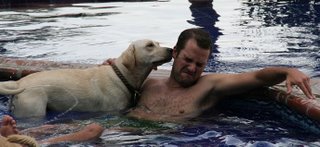
At midnight I was just about to give up on him when a taxi sped to the curb and Brooks popped out. ¨What´s up duid?¨ ¨Where the hell have you been?¨ ¨My bus got in early and I´ve been drinking beersks with Ruth and Horst back at your hotel since 8:30.¨ During the next few days, we hiked the Quetzal trail and drank
organic coffee in the mountains of central Panama. We also attempted to surf at my friend, Sed´s, ultra-plash Punta Barco beach house but Brooks spent most of his time fostering a relationship with the ferocious guard dog, Lucy. Finally, we spent three days touring the Panama Canal, Old Town and other sites near Panama City.
After Brooks left, I took a bus back to David and remounted my bike for the 325-mile stretch (including detours) along the Panamerican Highway to Panama City. Inspired by a recent newsletter from my
bike club in Seattle that specializes in endurance events, I ripped the entire distance in just over three days with another short pit-stop back at Sed´s beach house. I got a chill up my spine as I crossed the Bridge of the Americas and pedaled my 10,000th mile in the 9th country of this trip. I stopped at the Balboa Yacht Club for a few celebratory American-style cheese burgers and then tottered through a maze of busy one lane streets in downtown Panama City to my hotel. There I met up with Ruth and Horst and began to make plans for crossing into South America.
Stage 2, Part 5 Stats Miles: 1,638.1 miles
Elevation Gain: 78,210 ft.
Flat Tires: Gregg 2
Overall Expedition Stats Miles: 9,762.2 miles (not including around town miles)
Flat Tires: Gregg 12
Sponsored by: Co-Motion Cycles, Outdoor Research, Ortlieb, Rudy Project, ThinkHost, eRoi, Schwalbe North America, ZUM, Bay Club, Canright Interactive, R Bar, IBEX, Lombardi Sports, Jaunt
